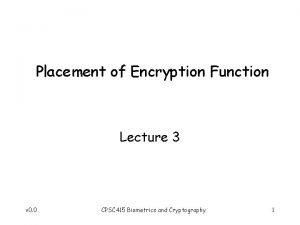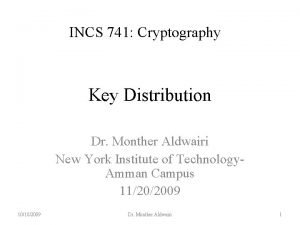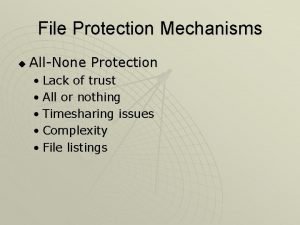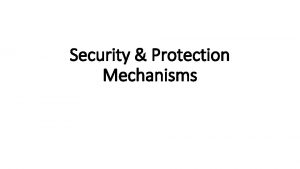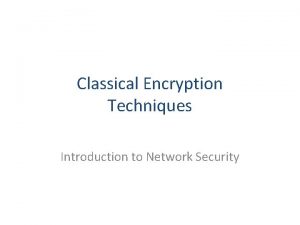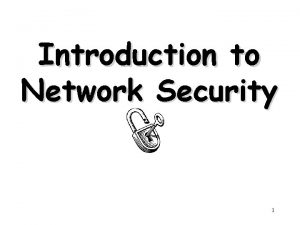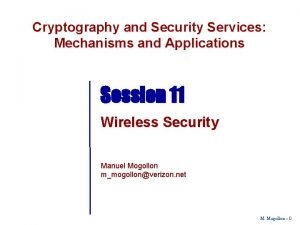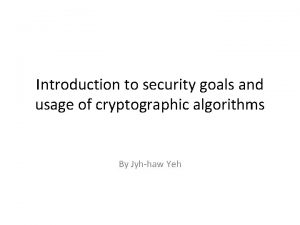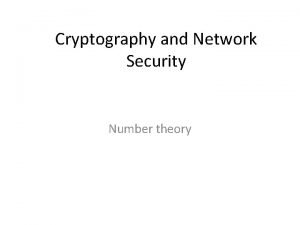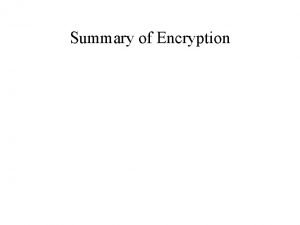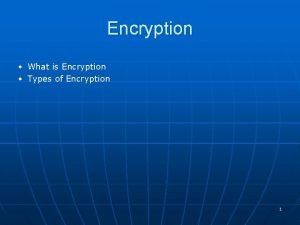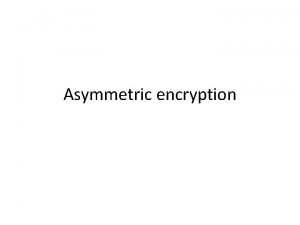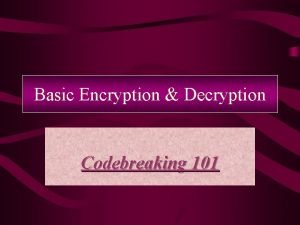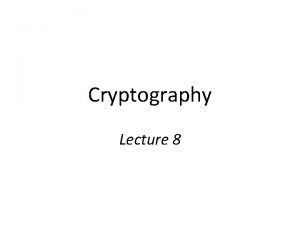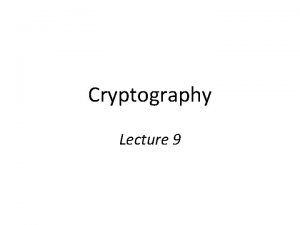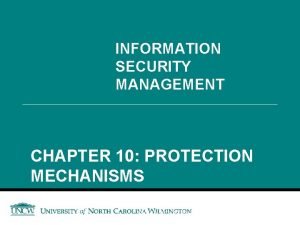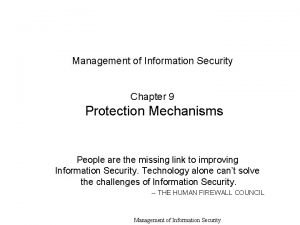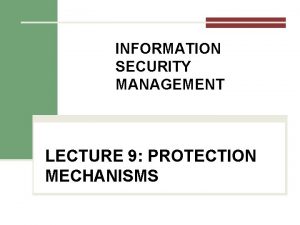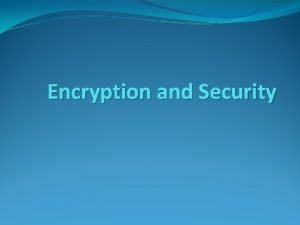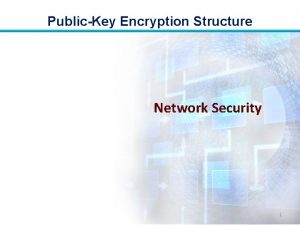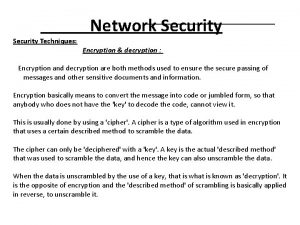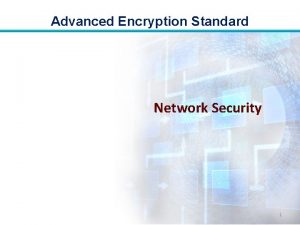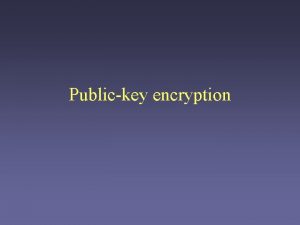INFORMATION SECURITY MANAGEMENT PROTECTION MECHANISMS CRYPTOGRAPHY Cryptography Encryption


























- Slides: 26

INFORMATION SECURITY MANAGEMENT PROTECTION MECHANISMS - CRYPTOGRAPHY

Cryptography • Encryption • Cryptology

Cryptography (cont’d. ) Cryptosystem • Algorithm • Keyspace Encipher Decipher

Common Ciphers Most commonly used algorithms include three functions: § Substitution § Transposition Plaintext: 0010… Key: 1 > 3, 2 > 4, 3 > 2, 4 > 1, … Example: FROM -> MOFR

Common Ciphers • XOR • • • ‘ 0’ XOR’ed with ‘ 0’ results in a ‘ 0’. (0 0 = 0) ‘ 0’ XOR’ed with ‘ 1’ results in a ‘ 1’. (0 1 = 1) ‘ 1’ XOR’ed with ‘ 0’ results in a ‘ 1’. (1 0 = 1) ‘ 1’ XOR’ed with ‘ 1’ results in a ‘ 0’. (1 1 = 0) If the two values are the same, you get “ 0”; if not, you get “ 1” Process is reversible; if you XOR the ciphertext with the key stream, you get the plaintext 10100100 10011010 10011000 10011010 01010111 01101001 01101011 01101001 11110011 11110011 = 10100100 10011010 10011000 10011010 = 01010111 01101001 01101011 01101001

Common Ciphers • Book or running key cipher – Uses text in a book as the algorithm to decrypt a message – The key relies on two components: • Knowing which book to use • A list of codes representing the page number, line number, and word number of the plaintext word

Symmetric Encryption – Known as private key encryption – Same key used to encrypt/decrypt the message

Symmetric Encryption Cryptosystem • Data Encryption Standard (DES) – Based on the Data Encryption Algorithm which uses a 64 -bit block size and a 56 -bit key – Cracked in 1997 – Triple DES (3 DES) improved version • Advanced Encryption Standard (AES) – Based on the Rinjndael Block Cipher • Variable block length and a key length of either 128, 192, or 256 bits

Asymmetric encryption Uses two different, but related keys § Either key used to encrypt/decrypt message § However, if Key A is used to encrypt the message, then only Key B can decrypt it; conversely, if Key B is used to encrypt a message, then only Key A can decrypt it Most valuable when one of the keys is private and the other is public

Asymmetric encryption Figure 10 -12 Public key encryption Source: Course Technology/Cengage Learning

Digital Signatures – Asymmetric process is reversed § The fact that the message was sent by the organization that owns the private key cannot be refuted § This nonrepudiation is the foundation of digital signatures • Based on: • Digital certificate • A certificate authority (CA)

Public key infrastructure (PKI) • The entire set of hardware, software, and cryptosystems necessary to implement public key encryption • PKI systems are based on public key cryptosystems and include digital certificates and certificate authorities

Encryption Operations (cont’d. ) • PKI provides the following services – – – Authentication Integrity Confidentiality Authorization Nonrepudiation

Hybrid Systems – Asymmetric encryption is typically employed in conjunction with symmetric key encryption, creating a hybrid system – Diffie-Hellman key exchange method – asymmetric encryption is used to exchange symmetric keys so that two organizations can conduct quick, efficient, secure communications based on symmetric encryption – Diffie-Hellman provided the foundation for subsequent developments in public key encryption

Encryption Operations (cont’d. ) Figure 10 -14 Hybrid encryption Source: Course Technology/Cengage Learning

Using Cryptographic Controls • Modern cryptosystems can generate unbreakable ciphertext • Cryptographic controls used for: – e-mail and its attachments – e-commerce transactions – remote access through VPN connections

Email Cryptographic Controls • Secure Multipurpose Internet Mail Extensions (S/MIME) • Privacy Enhanced Mail (PEM)

Email Cryptographic Controls • Pretty Good Privacy (PGP) – Uses the IDEA Cipher • A 128 -bit symmetric key block encryption algorithm with 64 -bit blocks for message encoding – Like PEM, it uses RSA for symmetric key exchange and to support digital signatures

Securing the Web • IP Security (IPSec) – The primary and dominant cryptographic authentication and encryption product of the IETF’s IP Protocol Security Working Group – Combines several different cryptosystems: • Diffie-Hellman key exchange • Public key cryptography • Bulk encryption algorithms • Digital certificates

Securing the Web • IPSec works in two modes of operation: – Transport • Only the IP data is encrypted, not the IP headers themselves • Allows intermediate nodes to read the source and destination addresses – Tunnel • The entire IP packet is encrypted and inserted as the payload in another IP packet – Often used to support a virtual private network

Securing the Web • Secure Electronic Transactions (SET) – Encrypts credit card transfers with DES for encryption and RSA for key exchange • Secure Sockets Layer (SSL) – Uses RSA for key transfer • On IDEA, DES, or 3 DES for encrypted symmetric key-based data transfer • HTTPS www. amazon. com

Securing the Web - SSL

Securing the Web • Secure Shell (SSH) – Provides security for remote access connections over public networks by using tunneling, authentication services between a client and a server – Used to secure replacement tools for terminal emulation, remote management, and file transfer applications

Hacking Cryptography Known plaintext attack Ciphertext-only attack Replay attack

Managing Cryptographic Controls • Don’t lose your keys • Know who you are communicating with • It may be illegal to use a specific encryption technique when communicating to some nations • Every cryptosystem has weaknesses • Give access only to those with a business need • When placing trust into a certificate authority, ask “Who watches the watchers? ”

Managing Cryptographic Controls (cont’d. ) • There is no security in obscurity • Security protocols and the cryptosystems they use are installed and configured by humans – They are only as good as their installers • Make sure that your organization’s use of cryptography is based on well-constructed policy and supported with sound management procedures
 Security mechanisms in cryptography
Security mechanisms in cryptography Security services and mechanisms in cryptography
Security services and mechanisms in cryptography Wireless security in cryptography
Wireless security in cryptography Placement of encryption function in cryptography
Placement of encryption function in cryptography Classical cryptography techniques
Classical cryptography techniques Placement of encryption function in cryptography
Placement of encryption function in cryptography Different file protection mechanisms
Different file protection mechanisms Different file protection mechanism
Different file protection mechanism Community based child protection mechanisms
Community based child protection mechanisms Private securit
Private securit Classical encryption techniques
Classical encryption techniques Security attacks services and mechanisms
Security attacks services and mechanisms Visa international security model
Visa international security model Explain about cnss security model
Explain about cnss security model Cryptography security services
Cryptography security services Modulo table
Modulo table Number theory in network security
Number theory in network security Firewall in cryptography and network security
Firewall in cryptography and network security Authentication in cryptography and network security
Authentication in cryptography and network security Intruders in cryptography and network security
Intruders in cryptography and network security Pigpen
Pigpen Primitive root in cryptography
Primitive root in cryptography Cryptography and network security 6th edition pdf
Cryptography and network security 6th edition pdf Cryptography and network security pearson
Cryptography and network security pearson Source
Source Cryptography and network security 4th edition
Cryptography and network security 4th edition Euler's theorem in cryptography and network security
Euler's theorem in cryptography and network security



